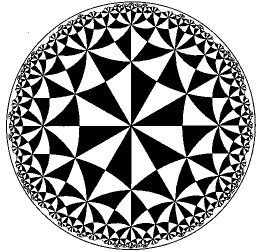
 |
Purpose To produce a tessellation of the Poincare disc using constructions from hyperbolic and Euclidean geometry.
Materials Paper, ruler, compass, pencil
ConclusionIf carried to its limit, this process generates a tiling of the Poincare disc by congruent hyperbolic triangles. To the Euclidean eye, as they approach the boundary of the Poincare disc these triangles appear to get smaller and smaller yet remain similar. We might expect the limit to be a fractal, but the tiles approach only the circle bounding the Poincare disc. This is not a fractal. This shows we must be careful. A multiplicative cascade of similar shapes does not necessarily converge to a fractal.